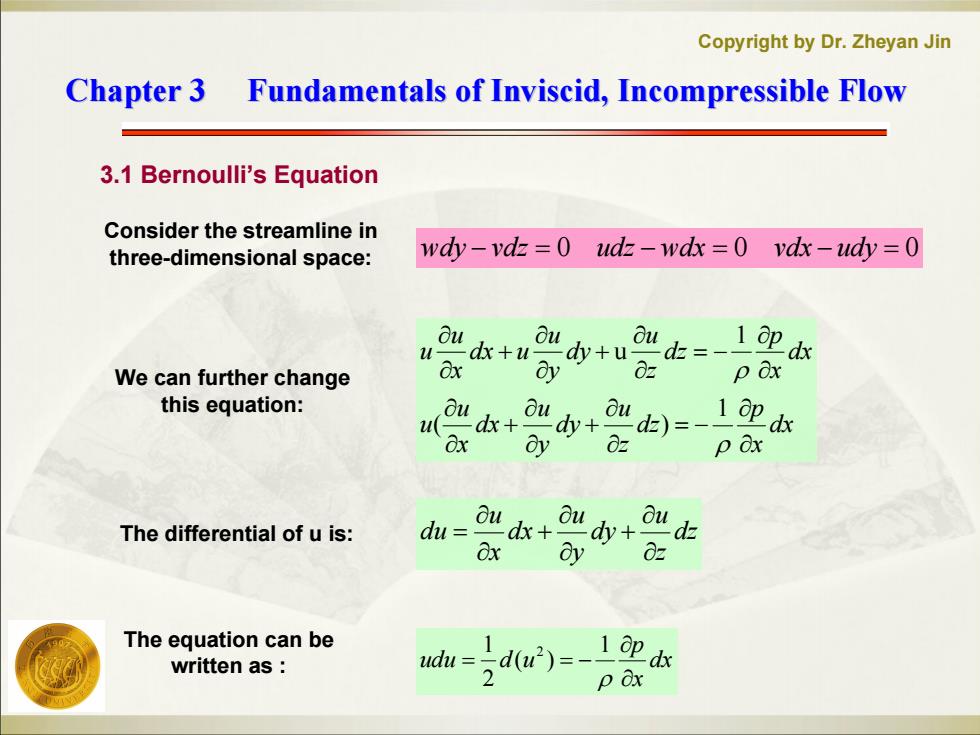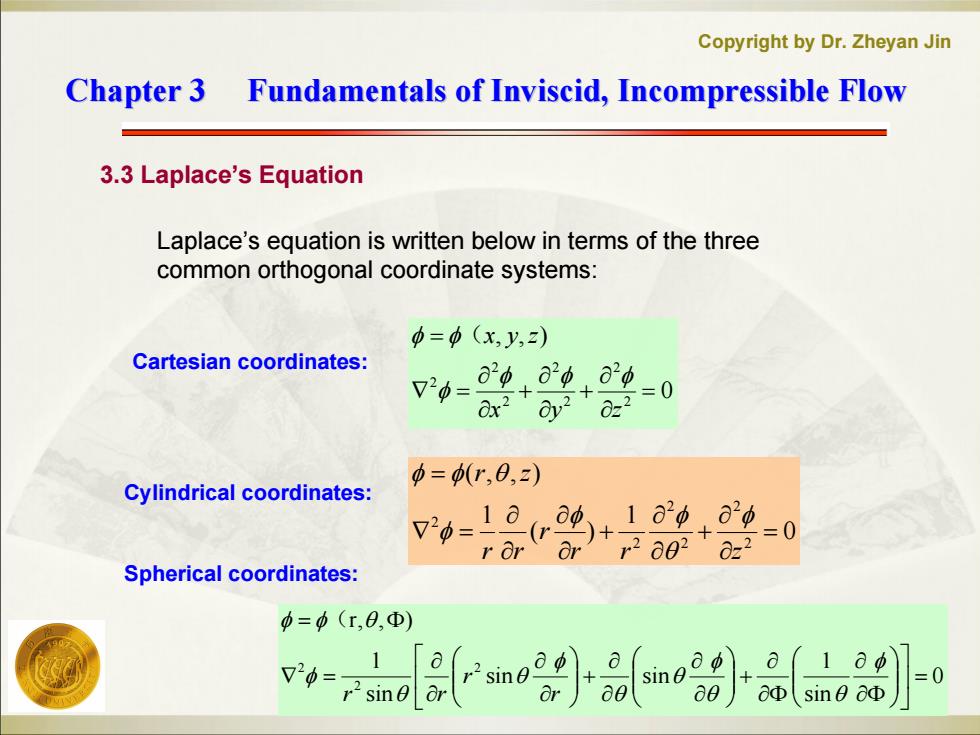
Copyright by Dr.Zheyan Jin Chapter 3 Fundamentals of Inviscid,Incompressible Flow 3.1 Bernoulli's Equation Consider the x component of the momentum equation: Du=_0p+pf,+(F.vw Dt dx Du=-卫 For an inviscid flow Dt dx with no body forces: p+pm0+pm0tv-卫 Ox dy du 1 ap For steady flow: p ox Multiply the above ou dx+v u ou dx+w dx = 1卫dk equation by dx: C D Ox
Copyright by Dr. Zheyan Jin Chapter 3 Fundamentals of Chapter 3 Fundamentals of Inviscid Inviscid, Incompressible Flow , Incompressible Flow 3.1 Bernoulli’s Equation For steady flow: Consider the x component of the momentum equation: x p z u y u v x u u 1 w x p z u y u v x u u t u x p Dt Du w x Fx viscous f x p Dt Du ( ) For an inviscid flow with no body forces: Multiply the above equation by dx: dx x p dx z u dx y u v x u u 1 dx w

Copyright by Dr.Zheyan Jin Chapter 3 Fundamentals of Inviscid,Incompressible Flow 3.1 Bernoulli's Equation Consider the streamline in three-dimensional space: wdy-vdz=0 udz-wdx=0 vdx-udy =0 ou dxu u ou dyu =-1pk We can further change Ox ay 0z pox this equation: ou dxy ou dy* db)=-12dh pOx The differential of u is: du= ou dx 8 ou dy aud也 oy dz The equation can be 1 written as: udu =-d(u2)=-- 1卫k 2 pox
Copyright by Dr. Zheyan Jin Chapter 3 Fundamentals of Chapter 3 Fundamentals of Inviscid Inviscid, Incompressible Flow , Incompressible Flow 3.1 Bernoulli’s Equation The differential of u is: Consider the streamline in three-dimensional space: dx x p dz z u dy y u dx x u u dx x p dz z u dy y u dx u x u u 1 ( ) 1 u dz z u dy y u dx x u du dx x p udu d u 1 ( ) 2 1 2 We can further change this equation: wdy vdz 0 udz wdx 0 vdx udy 0 The equation can be written as :

Copyright by Dr.Zheyan Jin Chapter 3 Fundamentals of Inviscid,Incompressible Flow 3.1 Bernoulli's Equation In a similar manner: 2w)=-12d w2)=-192d poy 2 P OZ 1 Thus,we have: w+2+w)=0++ Oy op d2) 2+v2+w2=V2 Due to the fact: p+吧d山+ 卫dk=dp The equation can be dp=-pVdv written as p Euler's equation It applies to an inviscid flow with no body forces,and it relates the change in velocity along a streamline dV to the change in pressure dp along the same streamline
Copyright by Dr. Zheyan Jin Chapter 3 Fundamentals of Chapter 3 Fundamentals of Inviscid Inviscid, Incompressible Flow , Incompressible Flow 3.1 Bernoulli’s Equation Due to the fact: In a similar manner: dp VdV dp d V 2 2 1 dz dp z p dy y p dx x p u v w V dz z p dy y p dx x p d u v w 2 2 2 2 2 2 2 ( ) 1 ( ) 2 1 Thus, w e have: The equation can be written as : dy p d y 1 (v ) 2 1 2 z z 1 ( w ) 2 1 2 d p d Euler’s equation It applies to an inviscid flow with no body forces, and it relates the change in velocity along a streamline dV to the change in pressure dp along the same streamline

Copyright by Dr.Zheyan Jin Chapter 3 Fundamentals of Inviscid,Incompressible Flow 3.1 Bernoulli's Equation For incompressible flow: The above equation can be easily integrated between any two points 1 and 2 along a streamline. V2 Sdp=-p[vdv V2 P,-=-p( Bernoulli's equation: n+2p=n+p Along a streamline: =const For an irrotational flow,the above equation is valid throughout the flow
Copyright by Dr. Zheyan Jin Chapter 3 Fundamentals of Chapter 3 Fundamentals of Inviscid Inviscid, Incompressible Flow , Incompressible Flow 3.1 Bernoulli’s Equation Bernoulli’s equation: For incompressible flow: 2 2 2 2 1 1 2 1 2 2 2 1 2 1 2 1 ) 2 2 ( 2 1 2 1 p V p V V V p p dp VdV V V p p Along a streamline: p V const 2 2 1 For an irrotational flow, the above equation is valid throughout the flow. The above equation can be easily integrated between any two points 1 and 2 along a streamline

Copyright by Dr.Zheyan Jin Chapter 3 Fundamentals of Inviscid,Incompressible Flow 3.1 Bernoulli's Equation The physical significance: When the velocity increases,the pressure decreases,and when the velocity decreases,the pressure increases. The strategy for solving most problems in inviscid,incompressible flow is as follows: 1.Obtain the velocity field from the governing equations. 2.Once the velocity field is known,obtain the corresponding pressure field from Bernoulli's equation
Copyright by Dr. Zheyan Jin Chapter 3 Fundamentals of Chapter 3 Fundamentals of Inviscid Inviscid, Incompressible Flow , Incompressible Flow 3.1 Bernoulli’s Equation The strategy for solving most problems in inviscid, incompressible flow is as follows: The physical significance: 1. Obtain the velocity field from the governing equations. 2. Once the velocity field is known, obtain the corresponding pressure field from Bernoulli’s equation. When the velocity increases, the pressure decreases, and when the velocity decreases, the pressure increases

Copyright by Dr.Zheyan Jin Chapter 3 Fundamentals of Inviscid,Incompressible Flow 3.2 Pressure Coefficient Pressure,by itself,is a dimensional quantity.The pressure coefficient is defined as: C。=P-p2 1 where qoo For incompressible flows,Cp can be expressed in terms of velocity only Consider the flow over an aerodynamics body immersed in a freestream with pressure p and velocity VPick an arbitrary point in the flow where the pressure and velocity are p and V,respectively.From Bernoulli's equation P.+V:-P+V:OF P-P.-0 (V-PV) 2p-2 The pressure coefficient: 1
Copyright by Dr. Zheyan Jin Chapter 3 Fundamentals of Chapter 3 Fundamentals of Inviscid Inviscid, Incompressible Flow , Incompressible Flow 3.2 Pressure Coefficient For incompressible flows, Cp can be expressed in terms of velocity only. Consider the flow over an aerodynamics body immersed in a freestream with pressure p ͚and velocity V͚. Pick an arbitrary point in the flow where the pressure and velocity are p and V, respectively. From Bernoulli’s equation where 2 2 1 V q q p p Cp 2 2 ( V 2 V 2 ) 2 1 V or 2 1 V 2 1 p p p p The pressure coefficient: Pressure, by itself, is a dimensional quantity. The pressure coefficient is defined as: 2 2 2 2 1 V 2 1 ( ) 2 1 V V V V q p p Cp

Copyright by Dr.Zheyan Jin Chapter 3 Fundamentals of Inviscid,Incompressible Flow 3.3 Laplace's Equation Continuity equation: +v.pV=0 t For incompressible flow,p =constant ap=0、 e(pV)=pv.V at 7.V=0 币=V中 For irrotational flow: 7·(V)=0 7b=0 Laplace's equation.Solutions of Laplace's equation are called harmonic functions
Copyright by Dr. Zheyan Jin Chapter 3 Fundamentals of Chapter 3 Fundamentals of Inviscid Inviscid, Incompressible Flow , Incompressible Flow 3.3 Laplace’s Equation Laplace’s equation. Solutions of Laplace’s equation are called harmonic functions. For incompressible flow, ρ=constant V 0 0 V V t ( ) V 0 t 0 ( ) 0 2 V For irrotational flow: Continuity equation:

Copyright by Dr.Zheyan Jin Chapter 3 Fundamentals of Inviscid,Incompressible Flow 3.3 Laplace's Equation Laplace's equation is written below in terms of the three common orthogonal coordinate systems: 中=φ(x,y,2) Cartesian coordinates: v0=0+8,o' Oxoo =0 p=(t,0,z) Cylindrical coordinates: vb=18 o 、,1a2中,a2 -(r =0 r2a02 0z2 Spherical coordinates: =(r,0,Φ) 1 7= 2 a a 1 in sin rsine a0 Φ sin0oΦ
Copyright by Dr. Zheyan Jin Chapter 3 Fundamentals of Chapter 3 Fundamentals of Inviscid Inviscid, Incompressible Flow , Incompressible Flow 3.3 Laplace’s Equation 0 , , ) 2 2 2 2 2 2 2 x y z x y z ( 0 1 ( ) 1 ( , , ) 2 2 2 2 2 2 r r z r r r r z Cartesian coordinates: Laplace’s equation is written below in terms of the three common orthogonal coordinate systems: Cylindrical coordinates: Spherical coordinates: 0 sin 1 sin sin sin 1 r, , ) 2 2 2 r r r r (

Copyright by Dr.Zheyan Jin Chapter 3 Fundamentals of Inviscid,Incompressible Flow 3.3 Laplace's Equation 1.Any irrotational,incompressible flow has a velocity potential and stream function that both satisfy Laplace's equation. 2.Conversely,any solution of Laplace's equation represents the velocity potential or stream function(two-dimensional)for an irrotational,incompressible flow. Note that Laplace's equation is a second-order linear partial differential equation.The fact that it is linear is particularly important,because the sum of any particular solutions of a linear differential equation is also a solution of the equation: 0=4+42+…+9
Copyright by Dr. Zheyan Jin Chapter 3 Fundamentals of Chapter 3 Fundamentals of Inviscid Inviscid, Incompressible Flow , Incompressible Flow 3.3 Laplace’s Equation 1 2 n 1. Any irrotational, incompressible flow has a velocity potential and stream function that both satisfy Laplace’s equation. Note that Laplace’s equation is a second-order linear partial differential equation. The fact that it is linear is particularly important, because the sum of any particular solutions of a linear differential equation is also a solution of the equation: 2. Conversely, any solution of Laplace’s equation represents the velocity potential or stream function ( two-dimensional) for an irrotational, incompressible flow

Copyright by Dr.Zheyan Jin Chapter 3 Fundamentals of Inviscid,Incompressible Flow 3.3 Laplace's Equation The general approach to the solution of irrotational,incompressible flows can be summarized as follows: 1.Solve Laplace's equation for or w along with the proper boundary conditions. 2.Obtain the flow pressure from V=or u=du/dy v=-dy/x 3.Obtain the pressure from Bernoulli's equation, 1 p+pV2=P.+pV2 2 Where P and are known freestream conditions
Copyright by Dr. Zheyan Jin Chapter 3 Fundamentals of Chapter 3 Fundamentals of Inviscid Inviscid, Incompressible Flow , Incompressible Flow 3.3 Laplace’s Equation 1. Solve Laplace’s equation for Φ or ψ along with the proper boundary conditions. 2. Obtain the flow pressure from The general approach to the solution of irrotational, incompressible flows can be summarized as follows: V u / y v / x 2 2 2 1 p 2 1 p V V p V or 3. Obtain the pressure from Bernoulli’s equation, Where and are known freestream conditions